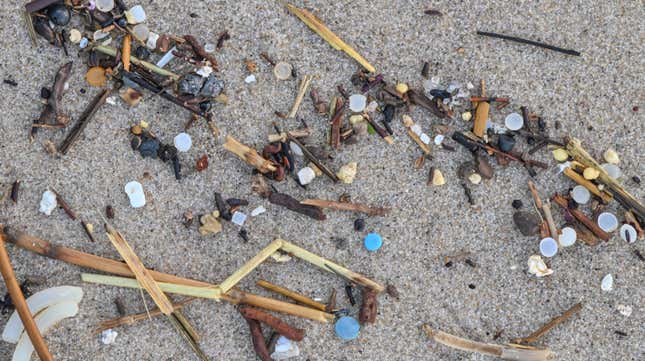
The world is covered with plastic pollution. That breaks down to become microplastics—tiny bits of plastic smaller than 5 mm. We know that it isn’t healthy to find these bits of plastic all over the planet (and in our bodies) but there isn’t much research on how this is going to affect mammals. A new study published this month in the International Journal of Molecular Science has tried to understand the long-term health impacts of this phenomenon and its findings are worrisome.
Researchers at the University of Rhode Island exposed mice to different levels of microplastics via their drinking water to research the impacts on behaviors and how the plastics build up in their bodies. Researchers observed that the microplastics accumulated in the tissue of multiple organs, including those outside of the digestive systems of the mice. Jaime Ross, a professor of neuroscience at the University of Rhode Island who was involved in the study, said that researchers were surprised to see how much microplastic had accumulated over time.
“We expected to see the microplastics in the feces of the animal, that wasn’t altogether surprising,” Ross told Earther. “Then we found them deep inside liver cells, spleen, [and] kidneys. Not just the center of the digestive tract, but actually in the tissue of the digestive tract.”
Because the plastics were found in organs including the liver, spleen, and brain, it meant that the many bits of swallowed microplastics had entered the bloodstream. This is what allowed the microplastics to make their way into organs outside of the digestive tract.
The team of researchers also looked at behavioral changes in mice that had steadily ingested microplastics, versus those that did not and those with lower levels of exposure. After three weeks of drinking microplastics in their water, the mice were placed in something called an open-field test. They explored a low-lit chamber for 90 minutes and their spontaneous movements were monitored.
“They don’t [usually] hang out waiting to be scooped up by a predator…they feel more protective along the sides,” Ross said. “We look at that type of behavior to understand: Are they going around the outside of this chamber? Are they going into the center?”
The mice that had higher exposures to microplastics in their water were more likely to be out in the open of the “field” environment compared to mice that were not exposed and those that had lower microplastic exposures. These mice had more erratic movements and traveled longer distances in the artificial field. This was especially notable in older mice. The differences in behavior were alarming, especially because the mice intentionally ingested the microplastics for only three weeks.
When the mice were studied, researchers also noticed inflammation in their brains. They also recorded a decrease in a glial fibrillary acidic protein, which is also known as GFAP. This is a protein that supports cell processes in the brain. Lower levels of this protein are associated with early stages of some neurodegenerative diseases including mouse models of Alzheimer’s disease, Ross said. The team hadn’t expected this finding, and they intend to conduct future research to further understand the role of microplastics in neurological disorders and disease.
“We want to understand the lifecycle of the microplastics in the body... understand what their fate is, once they’ve entered into the body,” Ross said. “And we want to understand how plastics may change the ability for the brain to maintain brain homeostasis.”
Ross hopes that this recently published work can be combined with other anti-pollution efforts to phase out unnecessary plastic items. “We need to rethink what kind of plastics we use, especially the single-use plastics that are not necessary for our environment, and for our health,” she said.
Want more climate and environment stories? Check out Earther’s guides to decarbonizing your home, divesting from fossil fuels, packing a disaster go bag, and overcoming climate dread. And don’t miss our coverage of the latest IPCC climate report, the future of carbon dioxide removal, and the un-greenwashed facts on bioplastics and plastic recycling.